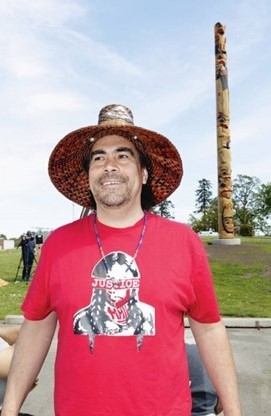Artist Bios
Myrna Crossley
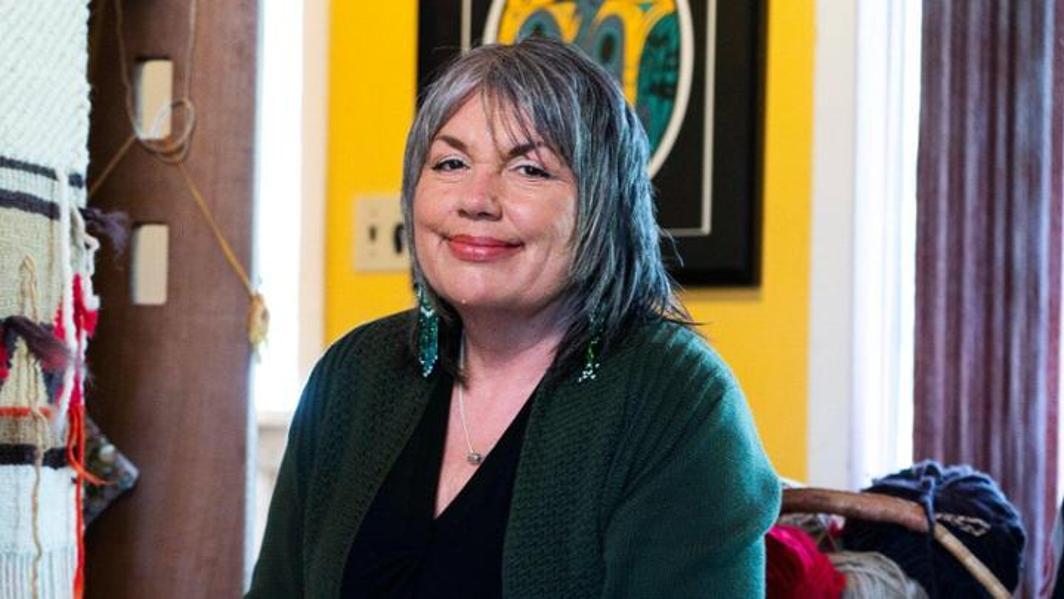
Myrna Crossley is a member of the Songhees Nation, of the lək̓ʷəŋən-speaking who are the traditional owners of the land now known as Victoria, BC. Her Indigenous roots come through her late maternal grandparents and mother, who were part of the Songhees and Esquimalt Nations. Her late father was a second-generation settler of English descent. Myrna has made her home on the Tsartlip reserve in W̱SÁNEĆ lands with her late husband and family since 1990.
Myrna began wool weaving in 1993, and she learned from Master Weaver Rita (Louis) Bob of the W̱SÁNEĆ Nations. Rita Bob was one of the women who was instrumental in the revival of Coast Salish Weaving; she shared her knowledge with students over the years both in Canada and the United States.
Myrna’s protocol for weaving starts with daily prayers, smudging and meditation, seeking guidance and giving gratitude. Projects in development must also be ‘covered’ at the end of each day until the project is complete; and prayers are offered in the harvesting of plant dye materials, giving thanks to the land for providing. Myrna adds:
“I enjoy all aspects of Salish weaving, from gathering the plant material for dyes, the spinning and finally the weaving. I feel fortunate to have been taught a skill that my ancestors practiced and with every blanket I weave I learn something new. I was given a treadle spinner handed down from my great-grandmother which inspired me to learn. Blankets have a significant importance in our culture and are used in many of our ceremonies and either worn or gifted at ceremonies. It is a practice that requires you to be of a good mind and spirit when working, otherwise the wool does not work with you. I consider myself a lifetime student of weaving and grateful for the teachings from my mentors, Elders, plants, and wool itself. I also give thanks for the opportunity to create and share this Blanket in this space of higher learning.”
Commissioned Works & Major Projects:
Myrna’s weavings are commissioned, locally and nationally and they are most often for cultural use; and Myrna has participated in some major projects:
- From 1999 to 2003, Myrna participated in the Annual “Coast Salish Artists and Friends Show,” held on the Saanich Peninsula for seven years, founded and organized by her late husband Charles Elliott, Master Salish Carver/Artist, herself, and other local artists.
- In 2001, Myrna made a blanket for a University of Victoria Indigenous Law Students, to hold ceremonial items for their national Kawaskimhon Moot. The blanket was gifted back to Myrna on March 10, 2023 and Myrna was told of the many gifts her blanket had held over the years.
- In 2021, Myrna made the ceremonial blanket for the Installation of the University of Victoria President Kevin Hall.
- In 2022, Myrna made a blanket for the Canadian Blood Services of Ottawa, Canada, to represent their commitment to Truth and Reconciliation.
- In 2022, Myrna participated in a family art show titled “JSIṈTEN ŚWELOꞢE – family growing ourselves up”. Hosted by the Salt Spring Community Arts Council and curated by Rose Spahan, the exhibit showcased works by Myrna, her late husband Charles Elliott, son Temoseng Chazz Elliott and nephew Matt Parlby and it included an art/history catalogue.
- In 2022, Myrna made the SIÁM SȽEȽWÁT NONET SWEꞢE,Ƚ, 'Highly Respected One's, Peace of Mind at Last’ Salish Woven Blanket, for the University of Victoria Student Services. This blanket was made to demonstrate the University’s commitment to reconciliation and meaningful engagement with the lək̓ʷəŋən and W̱SÁNEĆ This blanket is more for art than for cultural purposes since it will not be worn. The ‘Peace of Mind at Last' Blanket is in the student housing and dining building called čeqʷəŋin ʔéʔləŋ.
May Sam
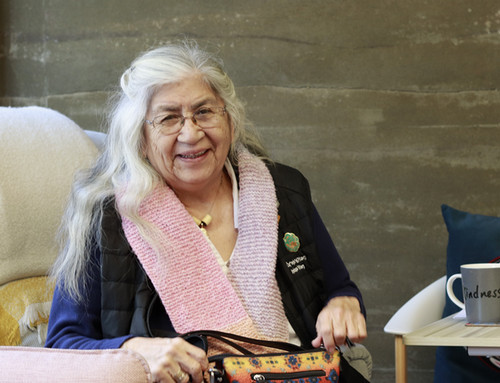
“I hug everybody. It’s a blessing. I put my arms on their shoulders and pray that they’re OK.”
May Sam’s inner warmth lights up any room she enters. She is well known at the First Peoples House, whether it’s in the Elders’ lounge chatting with students, or in the Ceremonial Hall providing an opening prayer for an event or ceremony. May has been part of the University of Victoria’s Elders’ Voices program for many years, along with her late husband Gabriel “Skip” Sam.
May was born in 1944 in Mill Bay and raised in Lhumlhumuluts’ in the Cowichan Valley. May attended St. Catherine’s Day School until grade seven. After she married Skip, May moved to Tsartlip where they spent many years farming and later working in the commercial fisheries.
“When we were younger, we worked in a potato patch and we worked hard for every potato that we picked,” May said. “Taking care, making sure we worked hard for what we earned. Then when we got a trawler, we became our own bosses but had to learn the reefs and the area and depth of the waters. We had to teach ourselves how to do that.” She has many wonderful memories of the years she and Skip fished together. “Those were the good old days,” she said. “The million-dollar life we didn’t realize it at the time.”
May is passionate about knitting. She spins her own wool and creates beautiful Cowichan hats, scarves, sweaters and other clothing. Her father Everest taught May how to knit and encouraged her creativity. She was featured in The Story of the Coast Salish Knitters, a documentary by Métis filmmaker Christine Welsh and was on the cover of Seaside Magazine.
May and Skip worked together as Elders for the Parks Canada Agency, often sharing their knowledge of the Gulf Islands and more recently they worked together for the Elders’ Voices program. “We were really proud to be with the youth,” May said. “Just talking to them and making sure they’re okay.”
May enjoys working with students and her warm personality is well known. “I hug everybody, even the first time I meet someone. It’s just the way I am,” she said. “I just like to greet everyone that way. It’s a blessing. And I put my arms on their shoulders and pray that they’re okay.”
“That’s our pride,” Skip once said, “to be with our grandchildren, nieces and nephews. I’m also glad to be with the students. They ask questions, I try to answer them. We are honoured to be here, for whatever they need.”
May and Skip are the parents of three children and twelve great- grandchildren. “Our family is just our whole pride and joy,” May said. “Our children and the work that they do taking care of people, we are really, really proud.”
Commissioned Works and Major Projects:
- In 2023, May donated the Mother Bear Blanket for the students and it is on display in Sŋéqə ʔéʔləŋ | Sngequ House.
- In 2022, May knitted the President’s Blanket for the Camosun College the retiring president Sherri Bell.
- In 2022, May was featured in a video production, “All the Love in the World” made by Katie and Caius.
- In 2019, May participated in the Indigenous Art Symposium with the City of Victoria, where she did workshops on the art of knitting, Cowichan style.
- In 2012, May was featured in a Globe and Mail article titled, “Cowichan Sweaters: From raw wool to cherished keepsake.” This was for the 100th Anniversary of the Cowichan knit sweater.
- In 2012, May was a Visiting Artist at the University of Victoria’s Anthropology 305: Anthropology of the Arts project. Her knitted sweater, toque, purse and socks, featuring a traditional Orca design are on display in the Art in the Cornett gallery.
- In 2012, May was a participant in the Artists in Residence project where she taught the art of knitting.
- In 2000, May was one of the featured knitters in Christine Welsh’s “The Story of the Coast Salish Knitters.”
pawackʷaačiiƛ, Geena Powa Haiyupis
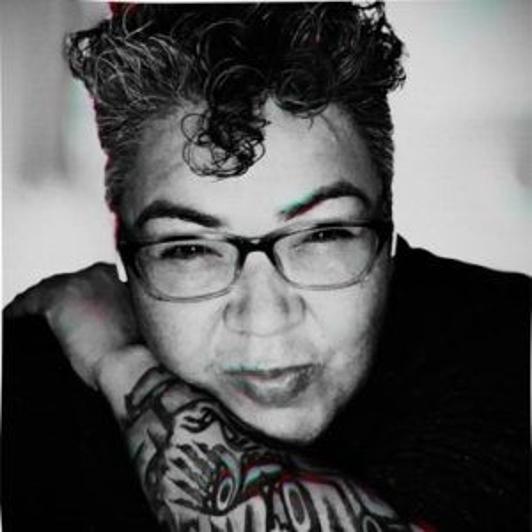
pawackʷaačiiƛ, Geena Powa Haiyupis is an inspired two-spirited artist with strong ties to her cultural
and familial roots. On her father and grandfather’s side, she belongs to the lək ʷəŋən and Penelekut
Nations and on her mother’s side, she belongs to the Hesquiaht, and Tla-o-qui-aht First Nations.
Geena’s Coast Salish and Nuu-chah-nulth roots are evident in her artwork, which she says is ‘from her
ancestors’ and is ‘written in her blood memories’.’.
Geena survived Christie Indian Residential School – an educational system that cost her People dearly. As a result, she is motivated and determined to learn the songs, stories, and language of her Elders. Geena flipped her paradigm on education by obtaining a Bachelor of Arts in Indigenous Studies and then she achieved her Master of Arts in Education and Leadership. Geena strongly believes in reviving and restoring Indigenous languages for future generations, and she strives to find creative ways to keep people engaged in learning.
Geena is a proud single parent of two young, culturally active men who inspire her to be a nurturing
mother. She is also an active community member, sharing her passion for language, art and education. Geena is committed to using her indelible personality to demonstrate a wealth of traditional life skills and she naturally perpetuates authentic traditional values. Geena did the logo for the University of Washington’s Indigenous Foods and Ecological Knowledge official site, and this includes a beautiful Artist Statement about the design on the logo:
“ʔiiqḥmuutaks ʔuyaqḥmis – I have an ancient story!”
She says, “when you are not okay, come visit me!” Because it is the land that brings recovery, strength
and comfort. She says, “when you are hungry or thirsty, I will provide for you!” Because the land is
wealthy and provides nutrition, life and healing. She says, “if you are lost and can’t find the way, then
sit and listen! Because I have an ancient story to tell you!”
Commissioned Works and Major Projects:
- In 2023, Geena created 5 unique designs for the large student housing building Sŋéqə ʔéʔləŋ | Sngequ House at the University of Victoria. The designs are vinyl art displayed on all the entrance way doors, numerous windows throughout the building, in several large plexiglass vinyl art pieces, one large, framed piece of the Building Name and one painted mural of the Frog and Lily Pads, located in the Indigenous Student Lounge.
- In 2023, Geena created the logo for the John Howitt Elementary School in Port Alberni, B.C. In this project the students helped paint the design.
- In 2022, Geena created “The Living Breath of wǝɫǝbʔaltxʷ’s” logo for the University of Washington’s Indigenous Foods and Ecological Knowledge official site. *see logo below*
- In 2022, Geena was a Founders Award recipient for her Master of Arts in Education and Leadership work at Royal Roads University.
- In 2022, Geena created the 20th Anniversary logo for the Alberni Valley Minor Lacrosse Association, which pays tribute to the history of lacrosse in the Valley and the country.
- In 2022, Geena created the logo for the Nuu chah nulth Community-Driven Diabetes Approach: Tee cha chitl – Getting Well Again project.
- In 2021, Geena guided the creation of a 2-D Canoe that was crafted by the students and is on display at the Alberni District Secondary School. The intent of this work was to foster a ‘stronger sense of belonging’ for the grade 8 students.
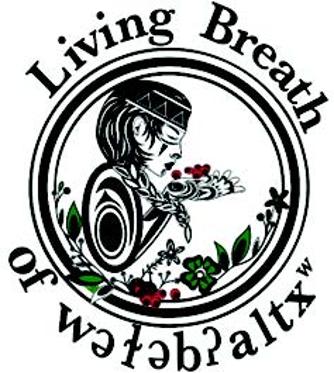
Darlene Gait
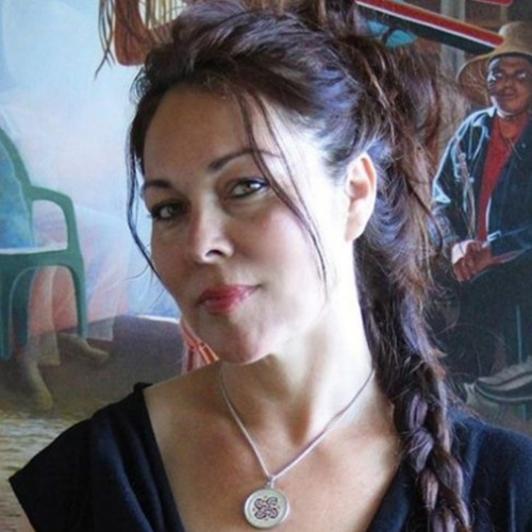
Darlene Gait was born in Victoria in 1969 and her Indigenous family roots are from the Lək̓ʷəŋən People of the Esquimalt Nation. Darlene credits her Grandmother Cooper as the most significant creative inspiration in her life. Her grandmother told her, “if you look into nature, you can see patterns up in the sky and on the earth and you can also see them within yourself”. As a child, Darlene was filled with curiosity about the natural world, and she says she drove Grandmother Cooper crazy with all her questions.
Darlene had many questions about the two different worlds she inhabited. There was the Scottish English world of her father’s family and the Coast Salish world on her mother’s side. Darlene came to realize that one was not necessarily better than the other but that there were extreme differences in manner, culture, food and art. As a child, she contemplated it often, but she did know that she was going to be an artist by the age of 10 when she started painting. By the time she was 15 years old, Darlene was ready to embark on a career in the art world.
Darlene struggled in the early years, in her efforts to blend her two very different worlds where some of her work was ‘not native enough’ and for others, it was ‘too native.’ During this period of her life, she connected with others who were struggling with their identity and were dealing with issues of racism, on both sides of their family. This struggle made her stronger and more determined and her artist expression came out early in her career through her many book illustrations. Darlene’s beautiful designs eventually made her an artist of renown and regard.
The word ‘Unity’ is often associated with Darlene’s work and in fact, it one of the core values she learned about in her decade of studying the Baha’i faith. She believes all things need to be united, “but the biggest thing you’re ever going to do is to find unity within yourself. I’m still working on it.”
Commissioned Works and Major Projects:
- In 2023, Darlene created the Orca and Wolf design for the windows and doors of the student housing and dining building, Čeqʷəŋín ʔéʔləŋ | Cheko’nien House.
- In 2021, Darlene created a copper adorned sculpture of Wolf and Raven for the Landmarks Public Art project by the Capital Regional District. This work is at Macauley Point Park.
- In 2019, Darlene was a Project Consultant for the Township of Esquimalt’s “The Art of Reconciliation Project”.
- In 2017, Darlene was selected from many artists to create an Orca design for the Salish Orca, BC Ferries new ferry for the Comox – Powell River route.
- In 2017, Darlene was the feature Artist for the annual BC Summer Reading Club, and for the British Columbia’s Library Association Annual Conference.
- In 2014, Darlene was featured in a Victoria Times-Colonist article on the unveiling of the seventh coin she had designed for the Royal Canadian Mint.
- In 2011, Darlene was a panelist on the Hiwest First Nation Artist Forum by the Art Galley of Greater Victoria.
- In 2008, Darlene is featured on ‘The New Canoe’ program that was aired on APTN and the A-Channel.
- In 2008, Darlene presented her painting, ‘The Wishing Fountain’ to Lieutenant-Governor Steven Point.
- From 1999 to 2008, Darlene’s work was distributed nationally and internationally by distributors who worked with Island Art Publishing.
- In 2007, Darlene opened her One Moon Gallery, with an unveiling ceremony and the raising of the totem pole that was made by her friend Doug LaFortune.
- In 2007, Darlene was a participant in the Spirit of Fall Native Art Exhibition at the Esquimalt Big House.
- From 2002 to 2006, Darlene was a children’s book illustrator with Orca Book Publishers.
Douglas (Bear) Horne
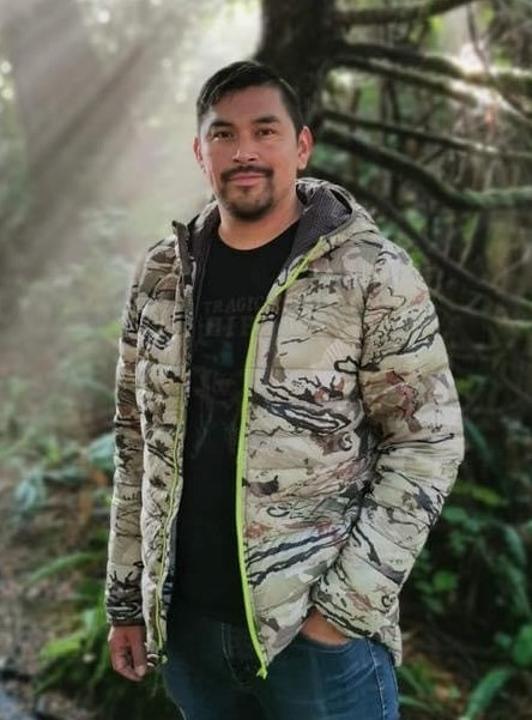
Douglas (Bear) Horne was born in Victoria in 1982 into a family of wood carvers and he has roots in the Coast Salish and Nuu-chah-nulth Nations. He grew up in the SȾÁ,UTW̱ (Tsawout) community in the W̱SÁNEĆ territories. Bear has been immersed in Coast Salish culture and art his whole life. He learned early about carving from his father Doug Lafortune and from his uncles Francis Horne and Perry Lafortune. Bear is grateful for his father and uncles for their generosity in sharing their knowledge and expertise with him. Bear completed his first carving at the age of eight and he has been carving on a full-time basis since 1998.
Bear’s passion for his art shines through the designs and carved and sculpted artwork that he creates. He likes to portray traditional Coast Salish crests and motifs but he is also interested in experimenting with unconventional forms, unique symbols, and different mediums. For example, Bear was the first Northwest Coast Indigenous artist to incorporate sand blasting into his works – the most notable being the ‘Cycle of Knowledge’ House Post for Camosun College’s 50th Anniversary celebration. Bears designs can be found in colouring books, on wallets, on drum bags, and on Insulated water bottles, stickers, on a reversible wrap and on small token-like pieces with words like ‘Totem Spirit – Hummingbird – Peace’.
Bear has dedicated over 25 years to creating Coast Salish art, and he has worked in various forms including carved house posts, poles, sculptures, masks, paddles, panels and jewellery and he has also created countless graphics. Because of his deeply rooted teachings and traditional upbringing, Bear is dedicated to preserving and passing his knowledge to his future generations. Bear imbues this belief in his art, which reflects the utmost respect for tradition and culture. Reflecting on his work, he said, “It’s special to use the skills that I’ve been taught and the traditions that have been passed on to me.”
Bear’s work is in numerous private collections throughout the world and is also in art galleries and public places, locally and nationally.
Commissioned Work and Major Projects:
- In November 2023, Bear made “ḴAḴEN SW͸ḴE¸ / Man House Post” for University of Victoria student housing and dining building Čeqʷəŋín ʔéʔləŋ | Cheko’nien House.
- In July 2023, Bear provided a copy of a painting that he created for each of the recipients of the 2023 Saanich Peninsula Local Hero Awards.
- In 2022, Bear created an “Every Child Matters” design for T-shirts and they were distributed by the United Food and Commercial Workers union Local 1518.
- In 2022, Bear designed the Logo for the Rural Coordination Centre of British Columbia for their Real-Time Virtual Support services.
- In 2021, Bear created the “Circle of Knowledge House Post” for Camosun College’s 50th Anniversary celebration.
- In 2017, Bear and his father Doug LaFortune carved a Welcome figure for Esquimalt High School and the Greater Victoria School District.
- In 2016, Bear was a contributor to the “Learn From the Animals of Salish Sea Colouring Book.”
KAtēwha‡et, Tom LaFortune
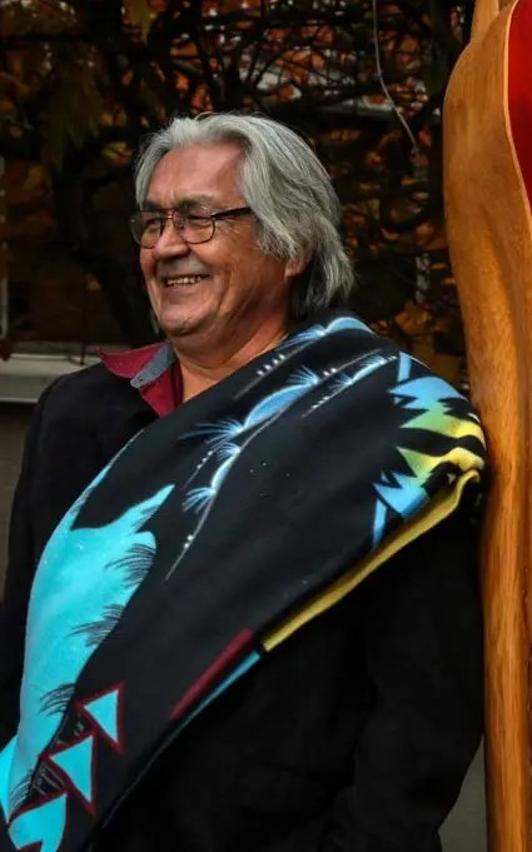
KAtēwha‡et, Tom LaFortune was born in Duncan in 1959 and is from W̱SĺḴEM (Tseycum First Nation) of the WSÁNEC peoples. He lives in the Victoria area with his partner and source of inspiration, Doreen. Tom has been carving since he was eleven years old. He honed his carving skills with the late master carver, Simon Charlie, while working alongside his brothers Doug LaFortune, Francis Horne and Perry LaFortune. His striking sculptured designs include masks, rattles, paddles, dishes, talking sticks, single figures, and countless story poles.
Tom is a celebrated Coast Salish artist, and he has been designing and carving for 50 years and he specializes in original and traditional Coast Salish art, hewn primarily from cedar. The Coast Salish aesthetic of specifically more rounded and realist in nature design is found in Tom’s work and his ability to unite his personal ancestral history with traditional Coast Salish carving techniques has made his work highly sought after and widely acclaimed. Every piece Tom creates, no matter the size, begins with an HB pencil and a piece of paper, where he lays out his ‘vision’ of the work at hand.
When commissioned to do work, Tom will listen carefully to what is being sought – what is the story that the buyer wants to tell, and from this he creates his vision. After the vision or the story is laid out, Tom methodically blocks out figures of people, animals, and ancestral patterns with practiced intuition, relying on his deep knowledge of the cultural significance of each figure. Manually transposing his drawings onto raw wood, using precise measurements, Tom begins to immortalize his design in wood, creating an appealing and often accurate aesthetic piece of art and culture.
Tom humbly continues to inspire and educate others at every opportunity, having mentored numerous other artists. Tom’s love of sharing his craft and teachings is most evident in a recent project with the Vancouver Island Regional Correctional Centre, where he shared the art of carving with inmates. Reflecting on his work there, Tom recalled a teaching he shared with the inmates when he said, “The old-timers always say you can’t build anything without a good foundation, and your foundation in life is your conscience,” and that “having a good conscience leads to having a good life.” Tom has a good heart and good mind, and this is always reflected in his extraordinary work.
Commissioned Works and Major Projects:
- In 2023, Tom, and Eddy Cliffe / hə' Yəł' Kən of the Wei Wai Kum Nation, created the House Post Facades for Sŋéqə ʔéʔləŋ | Sngequ House for the University of Victoria’s student housing and dining Indigenization Project.
- In 2022, Tom worked with the Vancouver Island Regional Correctional Centre where he helped inmates build community through a totem pole. This 41-foot totem pole is called the “Max Henry Memorial Pole.”
- In 2022, Tom carved a 20-foot Bear, Salmon and Eagle Totem Pole for the View Royal Fire Department.
- In 2021, Tom was featured in the VILL magazine in an article entitled, “The Larger Than-Life Works of Tom LaFortune: Legacy of a Master.”
- In 2018, Tom and his brother Perry LaFortune were featured on CBC News in an article entitled, “Crossing cultures and healing’: artists carve totem pole at Royal BC Museum,” for the provincial Ministry of Health.
- In 2017, Tom carved the 30-foot John Rice Sr. Memorial Welcome Pole for the Victoria International Marina, and it is installed at the Lime Bay Park, next to the Victoria International Marina.
- In 2017, Tom carved an archway or a welcome gate that welcomes visitors into Fort Rodd Hill National Historic Site.
- In 2015, Tom created S’ael, a 25-foot Totem Pole for the Royal Roads University’s 75th Anniversary (55 years as a Military College and 20 years as a public university).
- In 2015, Tom’s mask that was carved in 1986 was repaired and treated in celebration of National Aboriginal History Month. This was commissioned by L.V. Greyes Partnership, a company that brings together the expertise of work and cultural property.
- In 2014, Tom along with other artists, carved Totem Poles for the Songhees Wellness Centre project.
- In 2008, Tom carved a single Owl figure that overlooks the Ross Fountain in the world famous Butchart Gardens.
- In 1994, Tom carved a Totem Pole for the 1994 Commonwealth Games that occurred in the City of Victoria that year.
- In 1986, Tom carved the ‘Owl Spirit’ and the ‘Harvest Time’ Totem Poles for the City of Duncan’s Collection, and they part of the Walking Tour of Downtown Duncan Totem Poles.
hə' Yəł' Kən, Eddy Cliffe
Eddy Cliffe / hə' Yəł' Kən is from the Wei Wai Kum Nation, and he was born on June 17, 1977, in Campbell River, BC. Eddy was in sales for several years before he began work in the construction industry, where he worked primarily with concrete. Eddy grew in up in the lower mainland and central Vancouver Island, ending up in the Campbell River area once he began having children (4). Eddy has been in the Greater Victoria area for a couple of years now.
Eddy came to Victoria after a rough patch in life where he ended up in jail and this is where he met Tom LaFortune. Tom was the head carver for the joint John Howard Society and Province of BC initiative called the “Sacred Cedars” program. Eddy helped with the carving of the 41-foot XEUES SOŁ E TŦE ĆELÁṈEN totem pole that now sits outside the Wilkinson Road Jail. Eddy learned a great deal from Tom and was inspired by him to lead a more cultural lifestyle. Tom extended the opportunity to continue carving if Eddy took his parole in Victoria. The offer was accepted and the bond between mentor and mentee was formed and grew into a father-son like relationship.
Reflecting on his first experience with carving, Eddy said that his life was changed and that carving was a “promise within myself and to the community because of the strength of the symbolism of each creation”. With Tom’s guidance Eddy began carving seriously in 2022 and he is excited about combining his construction skills with his art. Eddy’s talent as a carver and designer are blossoming; in fact one of his frog designs is now being cast into concrete for outdoor furniture and he is currently collaborating with Victoria Concrete Solutions to take his dream into reality.
Commissioned Works and Major Projects:
-
In 2023, Eddy assisted Tom LaFortune with the creation of a pair of 10-foot house post facades for the University of Victoria’s student housing and dining building Sŋéqə ʔéʔləŋ | Sngequ House called, “The Hunter and the Gatherer”.
-
In 2023, Eddy carved a frog, bear rattle, 3 whales, a turtle bowl, a kuuloose bowl and 2 feathers for family members, friends and for people in Alabama, U.S.A. and Paris, France.
-
In 2022, Eddy was invited to his first ever Art Show, although he has not yet established a name in carving. Eddy was honoured to attend.
-
In 2022, Eddy was one of the men who carved with Tom LaFortune on a 41-foot XEUES SOŁ E TŦE ĆELÁṈEN / Max Henry Sr. totem pole totem pole for the Vancouver Island Regional Correctional Centre, Wilkinson Road location.
TEMOSEṈ, Charles Elliott Jr.
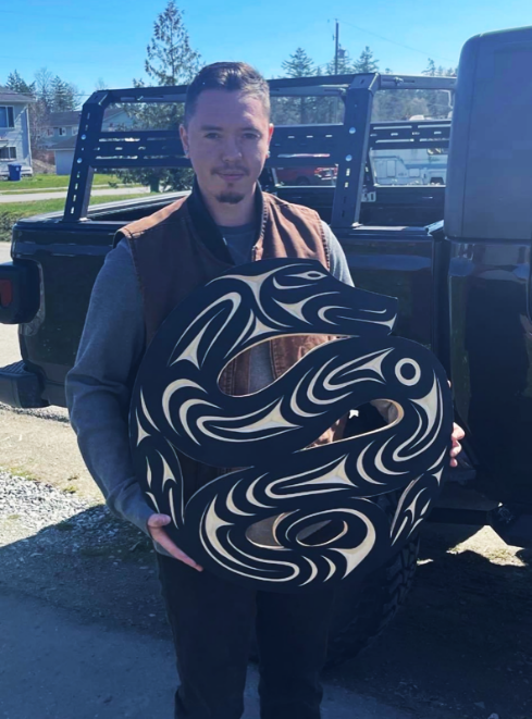
TEMOSEṈ, Charles (Chazz) Elliott Jr. was born in Saanich in 1995 and he has roots with the W̱SÁNEĆ and Lək̓ʷəŋən people. TEMOSEṈ was raised in W̱JOȽEȽP (Tsartlip) and he still resides there. Surrounded by family and culture, TEMOSEṈ began learning the ways of Coast Salish art and W̱SÁNEĆ teachings as a young boy.
TEMOSEṈ attributes his desire to practice Coast Salish art to his late father, TEMOSEṈŦET (Charles Elliott Sr.) and his mother Myrna Crossley-Elliott, a Salish wool blanket weaver, who inspired in him a passion for learning about plants. TEMOSEṈ intertwines the knowledge and teachings of both his mother and father into his work. From his father he learned the art of designing, carving and relating stories in visual art and from his mother, he learned about harvesting protocols, local plants and their many uses, including for medicines.
Reflecting on his art and culture, TEMOSEṈ says, “Salish art is like a visual document – it can be a retainer of knowledge to the beholder by telling a story through imagery.” Rather than the written word, he uses imagery to document and depict the stories, legends, and history; and his goal is to document knowledge through art. TEMOSEṈ says that the western way has had a “harmful impact on the plants, animals, lands, oceans and people.” He feels there is a way to address these matters with art.
Family is very important to TEMOSEṈ. He is very close with his mother and numerous other relatives and family in his close-knit First Nations community. TEMOSEṈ works closely with his brother Matt Parlby-Elliott, who is apprenticing with him. They work well together, often putting in long hours to complete projects. He says that his brother is “his hero” and that he is always there for him. Many of his other relatives will help with projects too. TEMOSEṈ says that they would be there in a heartbeat if he called. He also says, “the art I create is not about me, it’s about all of us!” Stating that, “It’s thanks to the people I come from, my relatives that I have, to share stories and knowledge and to draw inspiration from.”
TEMOSEṈ continues to build his knowledge and skills and he takes every opportunity to learn more about his culture, his history and his people. TEMOSEṈ’s work can be found in private collections around the world, and he has undertaken numerous public artworks project, been a panelist and participated and several art shows.
Commissioned Works and Major Projects:
- In January 2024, TEMOSEṈ and his brother Matt Parlby-Elliott created “ḴAḴEN SȽÁNI / Woman House Post” for Čeqʷəŋín ʔéʔləŋ | Cheko’nien House
- In October 2023, TEMOSEṈ was a panelist for a discussion of the interactive haptic map, Untitled ṮEṮÁĆES, an event hosted by Legacy Gallery Downtown.
- In June 2023, TEMOSEṈ and his brother Matt Parlby-Elliott created two Welcome Poles on SḴŦAḴ | Mayne Island, as part of the Campbell Bay Music Festival.
- In April 2023, TEMOSEṈ was the feature Artist in the 16th Annual Spring Art Show entitled “Archipelago – Contemporary Art of the Salish Sea,” for the Salt Springs Arts Community Arts Council.
- The Township of Sidney commissioned TEMOSEṈ to carve a spindle whorl piece, to recognize the W̱SÁNEĆ People, their customs, and traditions.
- In 2022, TEMOSEṈ carved 5 award plaques for the University of Victoria’s Faculty of Humanities annual staff and faculty awards.
- In 2022, TEMOSEṈ along with his late father TEMOSEṈŦET, his mother Myrna Crossley-Elliott and his brother Matthew Parlby-Elliott did an Art Show Exhibition entitled, “JSIṈSET ŚW̱ELO₭E | Family Growing Ourselves Up,” for the Salt Spring Arts, Community Arts Council.
- In 2022, TEMOSEṈ did the cover design for the Simon Fraser University’s “Income Support for B.C.s Indigenous population inadequate: Report.”
- In 2020, TEMOSEṈ and his late father TEMOSEṈŦET | Charles Elliott were featured in a video production for the 2020 Local Heroes’ Documentary Series.
- In 2020, TEMOSEṈ was interviewed for his work entitled, “SHELIS – Life”, which he did for the Legacy Art Gallery series, “To Fish as Formerly.”
- In 2018, TEMOSEṈ carved a house post for the Saanich School District for their central Saanich office.
- In 2018, TEMOSEṈ carved a new Welcome sign for his alma mater, Stelly’s Secondary School.
Hii nulth tsa kaa, Karla Point
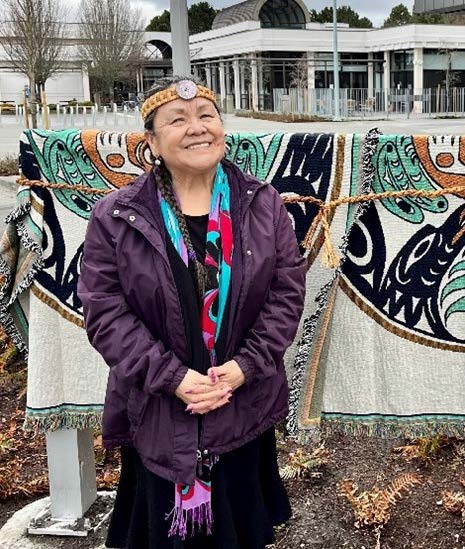
Karla Point / Hii nulth tsa kaa (On the Beach Welcoming) is from the Hesquiaht First Nation which is part of the Nuu chah nulth territories on the west coast of Vancouver Island. She has been married to Vern Point from Sts’ailes for over 44 years and they have three children and ten grandchildren. Vern and Karla have spent most of their lives in the Greater Victoria area and are grateful to the Lək̓ʷəŋən People of Songhees and Esquimalt for allowing them to live in their territories.
Karla is a third generation Indian Residential School Survivor. Her grandparents only had to attend for 6 years but both her parents attended for 12 years, with her father doing an extra year for a failed grade. When Karla was five years old, she was sent to Christie Indian Residential School, an experience she works to overcome to this day. It was December 1967 when Karla’s parents, Violet and Wilson George took her and her two brothers out of the residential school and moved off the Indian Reservation into town. Karla went on to attend 25 different public schools throughout Vancouver Island, the Lower Mainland and the Sunshine Coast.
Karla had seen so many injustices against her people and she saw that her people were suffering, so she decided that she wanted to go to law school. She graduated from the University of Victoria’s Faculty of Law program in 2006. It was not an easy journey for Karla; with only a Diploma in Criminal Justice from Camosun College, she attended first year law in 1998 and was not successful. After achieving a Bachelor of Arts degree in Humanities with a Major in Women Studies and a Minor in English, Karla returned to law school in 2003 and successfully graduated in 2006.
Karla decided not to practice law because she felt that she would be contributing to further oppression of Indigenous People. Instead, she decided to use her knowledge in indigenization and decolonization work. While working as the Cultural Support Liaison at the law school, Karla’s father became gravely ill. It was during this time that she began to work with cedar bark again. Cedar became medicine for Karla and helped with healing from the loss of her beloved father.
As a young woman, Karla was introduced to cedar bark by Hesquiaht Elder Alice Paul, who taught her how to gather, prepare and work with the bark. Karla later honed her cedar bark weaving skills with fellow Hesquiaht weavers Mariah (Galbraith) Desnoyer, Betty Lucas, Lisa Sabbas and Pamela Mickey. In her spare time, Karla makes cedar bark hats, headbands, baskets, bracelets and floral arrangements, many of which were funeral casket sprays. She has also taught cedar bark workshops in hat-making, headbands, bracelets, bookmarkers and decorative roses and hearts.
Commissioned / Donated Works and Major Projects:
- In 2024, Karla made the Canoe Journey Cedar Mat for the University of Victoria’s student housing and dining capital indigenization project and it’s on display in the Sŋéqə ʔéʔləŋ | Sngequ House Classroom foyer.
- In 2023, she taught a cedar bark workshop with the staff from the Office of the Vice-President Indigenous at the University. Participants made cedar roses, a cedar rose wreath, cedar hearts and headbands.
- In 2023, she made a fedora style cedar hat for law professor retiree Calvin Sandborn.
- In 2022, she made a traditional cedar hat for Cowichan Elder Philomena Williams (Pagaduan) and a cedar bark grad cap for Theresa Seymour.
- In 2022, she taught a cedar bark workshop with the public for students undertaking the course with the University of Victoria Continuing Studies department.
- In 2021, she made 6 traditional hats for Audrey Morrison-Wood and traditional cedar hats for First People’s House Elder May Sam; David Peter from Sts’ailes; and Tracey Underwood from W̱SÁNEĆ and she made a grad cap for Sam Chester.
- In 2020, she made 6 traditional hats and 6 headbands for Sally Hope for the Hereditary Chiefs of her Nation.
- In 2019, she made a traditional hat for actor Jason Momoa and presented it to him at an event held for him in the Sts’ailes community. She made traditional hats for former Members of Parliament Jody Wilson-Raybould and Jane Philpott and the hats were presented at a ceremony that Sts’ailes held for them.
- In 2019, she made a traditional hat for respected Sts’ailes Elder Virginia Peters on her retirement; she also made a fedora style hat for Nancy Pat Charlie from Sts’ailes and a cowboy style hat for Patty Blais.
- In 2018, she taught a series of 8 cedar hat making workshops in the Sts’ailes community where approximately 8 weavers made traditional hats; and she did a workshop with the Sts’ailes Business Development staff and for the public at the annual Harrison Lake Art Festival.
- In 2016, she made a traditional style cedar hat for former law dean Jeremy Webber.
- In 2014, she made 6 traditional hats for the UVic Indigenous law graduates from that year; she taught a workshop with some law faculty members; and she did a workshop with some grade 4/5 students at the Oak and Orca Independent School.

